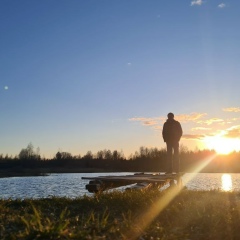Когда в 1995 году четырнадцать волков были выпущены на волю в Йеллоустонском национальном парке, ученые и не подозревали, что это кардинально изменит всю экосистему парка.
Волков не было в парке 70 лет, и всё это время там царствовали олени, которые за годы бесконтрольного размножения (все усилия людей по контролю их популяции не приносили успеха) нанесли сильнейший урон местной флоре. Четырнадцать волков, конечно, не смогли съесть всех оленей, но они заставили тех осторожнее выбирать места для пастбищ и избегать некоторых участков парка. На тех местах начала возрождаться растительность. За шесть лет количество деревьев увеличилось в пять раз. Появились бобры, которым деревья нужны для постройки плотин. В заводях завелись ондатры, утки и рыбы. Волки уменьшили популяцию шакалов, что привело к увеличению количества зайцев и мышей, а те в свою сторону привлекли в парк ястребов, хорьков и лис. В парк пришли медведи, так как они смогли отгонять волков от их добычи или доедать их объедки. В парке увеличилось количество ягод.
Но самое удивительное, волки изменили течение рек. Их русла выпрямились и стабилизировались, уменьшилась эрозия берегов. Случилось это потому, что влияние волков на оленей привело к взрывному росту деревьев и травы по берегам рек, что привело к их укреплению. Поменялась сама география парка, а всё благодаря четырнадцати волкам, выпущенным туда менее двадцати лет назад.
Волков не было в парке 70 лет, и всё это время там царствовали олени, которые за годы бесконтрольного размножения (все усилия людей по контролю их популяции не приносили успеха) нанесли сильнейший урон местной флоре. Четырнадцать волков, конечно, не смогли съесть всех оленей, но они заставили тех осторожнее выбирать места для пастбищ и избегать некоторых участков парка. На тех местах начала возрождаться растительность. За шесть лет количество деревьев увеличилось в пять раз. Появились бобры, которым деревья нужны для постройки плотин. В заводях завелись ондатры, утки и рыбы. Волки уменьшили популяцию шакалов, что привело к увеличению количества зайцев и мышей, а те в свою сторону привлекли в парк ястребов, хорьков и лис. В парк пришли медведи, так как они смогли отгонять волков от их добычи или доедать их объедки. В парке увеличилось количество ягод.
Но самое удивительное, волки изменили течение рек. Их русла выпрямились и стабилизировались, уменьшилась эрозия берегов. Случилось это потому, что влияние волков на оленей привело к взрывному росту деревьев и травы по берегам рек, что привело к их укреплению. Поменялась сама география парка, а всё благодаря четырнадцати волкам, выпущенным туда менее двадцати лет назад.
When in 1995 fourteen wolves were set free in Yellowstone National Park, scientists did not even suspect that this would drastically change the entire ecosystem of the park.
There were no wolves in the park for 70 years, and all this time deer reigned there, which over the years of uncontrolled reproduction (all people's efforts to control their population did not bring success) caused great damage to the local flora. Fourteen wolves, of course, could not eat all the deer, but they made them more cautious to choose places for pastures and avoid some parts of the park. Vegetation began to revive in those places. In six years, the number of trees has increased fivefold. There were beavers who need trees to build dams. Muskrats, ducks and fish are brought into the backwaters. The wolves reduced the jackal population, which led to an increase in the number of hares and mice, and they attracted to the park hawks, ferrets and foxes. The bears came to the park, as they were able to drive the wolves away from their prey or eat up their leftovers. The number of berries in the park has increased.
But the most amazing thing is that wolves have changed the course of rivers. Their beds straightened and stabilized, the erosion of the coast decreased. This happened because the influence of wolves on deer led to the explosive growth of trees and grass along the banks of the rivers, which led to their strengthening. The geography of the park itself has changed, thanks to fourteen wolves released there less than twenty years ago.
There were no wolves in the park for 70 years, and all this time deer reigned there, which over the years of uncontrolled reproduction (all people's efforts to control their population did not bring success) caused great damage to the local flora. Fourteen wolves, of course, could not eat all the deer, but they made them more cautious to choose places for pastures and avoid some parts of the park. Vegetation began to revive in those places. In six years, the number of trees has increased fivefold. There were beavers who need trees to build dams. Muskrats, ducks and fish are brought into the backwaters. The wolves reduced the jackal population, which led to an increase in the number of hares and mice, and they attracted to the park hawks, ferrets and foxes. The bears came to the park, as they were able to drive the wolves away from their prey or eat up their leftovers. The number of berries in the park has increased.
But the most amazing thing is that wolves have changed the course of rivers. Their beds straightened and stabilized, the erosion of the coast decreased. This happened because the influence of wolves on deer led to the explosive growth of trees and grass along the banks of the rivers, which led to their strengthening. The geography of the park itself has changed, thanks to fourteen wolves released there less than twenty years ago.

У записи 98 лайков,
5 репостов.
5 репостов.
Эту запись оставил(а) на своей стене Boris Gabisonia



































































